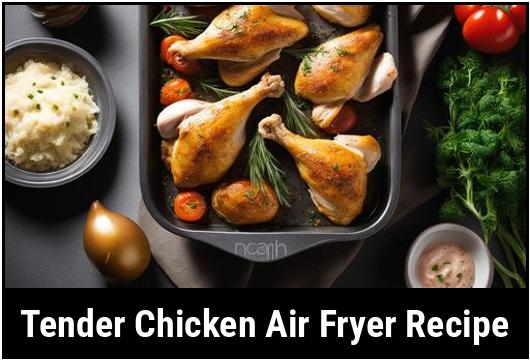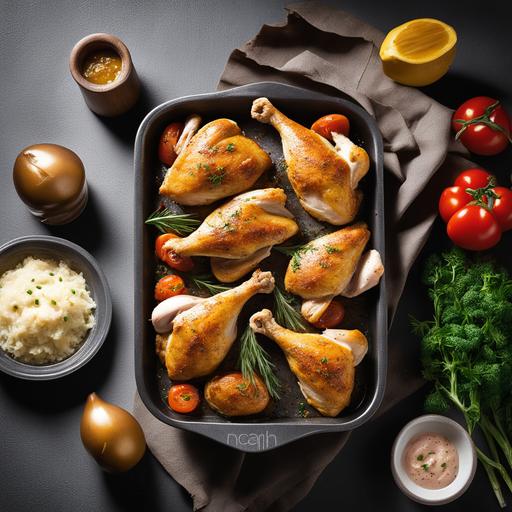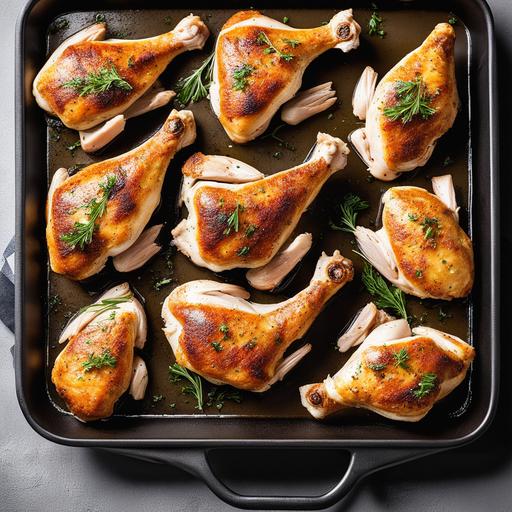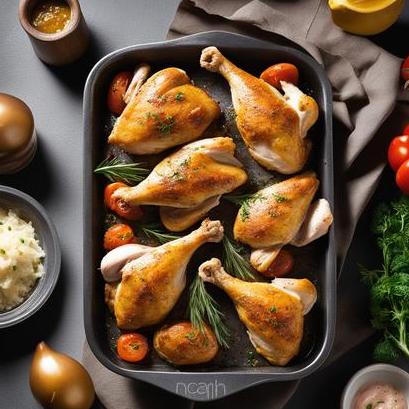Enhance Your Cooking Experience With Tender And Crispy Chicken Using An Air Fryer

Are you tired of the same old greasy chicken that leaves you feeling guilty and heavy? Look no further! In this comprehensive guide, we will explore the art of cooking tender chicken using an air fryer. From the food science behind achieving optimal results to culinary details, selection, cleaning, preparation, useful tips, variations, doneness checks, and, of course, the mouthwatering recipe, we’ve got you covered.
Get ready to revolutionize your cooking experience and impress your taste buds with tender, flavorful, and guilt-free air-fried chicken!
Food Science: The Magic Behind Tender Air-Fried Chicken
Understanding the Role of Temperature and Cooking Time
To achieve tender chicken in an air fryer, it is crucial to understand the science behind it. Unlike traditional frying methods that rely on oil to transfer heat, air fryers use powerful convection currents to circulate hot air around the food, creating a crispy texture.
The high temperature of air fryers (typically ranging from 350°F to 400°F) causes the moisture inside the chicken to evaporate rapidly, resulting in a perfectly crispy exterior. However, it is essential to strike a balance between temperature and cooking time to ensure the meat remains tender and juicy.
The Effect of Marinating on Tenderizing Chicken

Marinating chicken before air frying can significantly enhance its tenderness and flavor profile. The acidic ingredients commonly found in marinades, such as lemon juice or vinegar, break down the muscle fibers in the meat, resulting in a softer texture. Additionally, herbs, spices, and seasonings in the marinade infuse the chicken with aromatic flavors.
The Maillard Reaction: Creating Flavor Bombs
Ever wondered how your favorite grilled or pan-fried chicken develops those delicious browned crusts? The answer lies in the Maillard reaction. When proteins and sugars in the chicken’s surface are exposed to high heat, a complex set of chemical reactions occurs, resulting in enhanced flavors, aromas, and irresistible textures.
Air fryers excel at creating this Maillard reaction, providing you with the perfect combination of tender meat and a golden, crunchy exterior.
Culinary Details: Choosing the Right Chicken Cuts
The Magic of Bone-In Chicken
When it comes to air frying, bone-in chicken pieces, such as drumsticks or thighs, offer several advantages. The bones act as heat conductors, promoting even cooking throughout the piece. Additionally, the bone-in cuts retain moisture effectively, resulting in juicier and more succulent meat.
Skin-On or Skin-Off: A Matter of Preference
Whether you prefer crispy chicken skin or a healthier alternative with less fat, the choice of keeping the skin on or off is entirely up to you. Air fryers excel at creating crispy chicken skin, while simultaneously rendering out the excess fat during the cooking process.
However, if you opt for skinless chicken, the air fryer can still produce incredibly juicy and flavorful results. Just keep in mind that marinating the meat beforehand will help retain moisture in the absence of the protective skin.
Selection and Cleaning: Choosing the Perfect Air Fryer and Keeping It Sparkling Clean

Selecting the Right Air Fryer for Your Needs
Before delving into the preparation process, it is essential to choose an air fryer that suits your preferences and cooking goals. Consider factors such as capacity, power, and smart features. Nowadays, air fryers come in various types, including countertop models, toaster oven combinations, or even built-in varieties to seamlessly integrate into your kitchen setup.
Cleaning Your Air Fryer: A Breeze of Fresh Air
Keeping your air fryer clean is vital to ensure optimal performance and longevity. Most air fryers feature dishwasher-safe components, such as the frying basket and removable trays. However, it is always recommended to hand wash them to prevent potential damage caused by the dishwasher’s heat and chemicals.
To clean the interior, simply wipe it down with a damp cloth or sponge, ensuring all food residues are removed. Regular maintenance of your air fryer will guarantee that each use brings forth the best flavors and results.
Preparation: Transforming Raw Chicken into a Flavorful Delight
Thawing Chicken Correctly
Before embarking on your air frying adventure, it is important to thaw frozen chicken properly. The two recommended methods are refrigerator thawing and cold-water thawing.
Refrigerator thawing involves placing the chicken in its original packaging or a resealable bag on a plate and letting it thaw in the refrigerator. This method requires planning, as it can take several hours or even overnight.
Cold-water thawing is a quicker alternative. Submerge the chicken, securely packaged, in a large bowl of cold water. Change the water every 30 minutes to ensure a constant low temperature. Remember to promptly cook the chicken after thawing using this method.
Prepping Chicken: The Key to Flavorful Results

Once your chicken is well-thawed, it’s time to prepare it for the air fryer. Start by patting the chicken pieces dry with a paper towel to remove excess moisture, allowing for better browning.
If you’re marinating the chicken, now is the time to immerse it in a flavor-packed marinade of your choice. Ensure each piece is evenly coated and let it marinate in the refrigerator for at least 30 minutes, but no longer than 24 hours to avoid an overly tenderized texture.
In case you wish to go for a dry rub or a simple seasoning approach, generously season the chicken with your preferred herbs, spices, or a blend of both. Allow the chicken to rest at room temperature for approximately 10-15 minutes, ensuring the flavors permeate the meat.
Useful Tip: Elevating Your Chicken
To achieve an even airflow and crispy texture, consider elevating your chicken pieces slightly above the air fryer’s basket. This can be done by placing a rack or using metal skewers to keep the chicken elevated. Not only does this enhance the overall texture, but it also reduces the chances of the chicken sticking to the basket.
Tips and Variations: Elevate Your Chicken Game to New Heights
Utilizing Oil for Enhanced Texture
While air frying requires little to no oil, adding a small amount can enhance the texture and flavor of your chicken. A light coat of oil will help promote browning and create a crispy exterior. Alternatively, you can brush the chicken with oil before placing it in the air fryer, ensuring an even distribution.
Experimenting with Breading and Coatings
For those craving a chicken dish reminiscent of traditional deep-fried delights, breading and coatings are the way to go. Consider using ingredients such as breadcrumbs, panko, crushed cornflakes, or even crushed potato chips to create a crispy and flavorful exterior.
To achieve an extra crispy crust, a common technique involves dipping the chicken in flour, then an egg wash, and finally coating it with your desired breading mixture. This three-step process locks in moistness while delivering an unforgettable crunch.
Introducing Flavorful Infusions
Air frying is not solely reserved for classic recipes. Get creative and experiment with infusing your chicken with global-inspired flavors. Consider marinating the chicken in a teriyaki sauce for a touch of Asian fusion or seasoning it with a mix of cumin, coriander, and paprika for a flavorful Middle Eastern twist.
The possibilities are endless. Let your imagination run wild, and transform your air-fried chicken into an international culinary adventure!
Doneness Checks: Ensuring Perfectly Cooked Chicken Every Time

The Importance of Internal Temperature
To ensure your chicken is cooked through thoroughly, it is essential to monitor the internal temperature. The FDA recommends cooking poultry to an internal temperature of 165°F (74°C) to eliminate any harmful bacteria. Using a meat thermometer allows for precise measurements, guaranteeing safe and delicious results.
Pierce the thickest part of the chicken, avoiding any bones, with the thermometer. If the temperature reaches the recommended 165°F (74°C) or higher, your chicken is ready to be savored!
Visual Cues of Doneness
If you prefer using visual cues to determine the doneness of your chicken, look out for a golden-brown exterior with visible crispiness. It should be uniformly colored and devoid of any pink undertones near the bone. The meat should be tender and juicy, further indicating that it is cooked to perfection.
Additional Tip: Resting the Chicken
After removing the chicken from the air fryer, it is integral to let it rest for a few minutes. This resting period allows the residual heat within the meat to redistribute, resulting in a juicier and more succulent final product. Resist the temptation to dive in immediately, and let your patience be rewarded!
Tender Chicken Air Fryer Recipe: Mouthwatering Delight Awaits
Crispy Air-Fried Chicken Drumsticks
Ingredients:
- 6 chicken drumsticks, bone-in, skin-on
- 2 tablespoons olive oil
- 1 teaspoon salt
- 1 teaspoon paprika
- 1 teaspoon garlic powder
- 1 teaspoon onion powder
- 1/2 teaspoon black pepper
- Optional: Your preferred dipping sauce for serving
Instructions:
- Preheat your air fryer to 400°F (200°C) for approximately 5 minutes.
- In a small bowl, combine the salt, paprika, garlic powder, onion powder, and black pepper to create a seasoning blend.
- Pat dry the drumsticks with a paper towel to remove excess moisture.
- Place the drumsticks in a large bowl and drizzle them with olive oil. Mix well to ensure the oil coats each piece evenly.
- Sprinkle the seasoning blend generously over the drumsticks, massaging the spices into the meat.
- Carefully place the drumsticks in a single layer within the air fryer basket, ensuring they are not overcrowded.
- Air fry the drumsticks for 25-30 minutes, flipping them halfway through the cooking process for even browning.
- Check the internal temperature of the drumsticks using a meat thermometer, ensuring it reaches a safe 165°F (74°C).
- Once cooked, transfer the drumsticks to a plate or serving platter and allow them to rest for 5 minutes.
- Serve your delicious crispy air-fried drumsticks with your preferred dipping sauce or alongside a refreshing salad.
Additional Note: Adjusting Cooking Time
The cooking time may vary slightly depending on the size and thickness of the drumsticks. Thicker drumsticks might require a few extra minutes to cook through completely. Always rely on the internal temperature and visual cues to confirm doneness.
Conclusion
Congratulations! You are now equipped with the knowledge to create tender, crispy chicken masterpieces using an air fryer. From understanding the science behind air frying to culinary details, selection, cleaning, preparation, tips, and variations, you have all the tools necessary for a successful cooking journey.
Remember, the key to achieving tender chicken lies in the delicate balance of temperature, time, and seasoning. Feel free to experiment with marinades, coatings, and flavors from around the world to elevate your air-fried chicken game.
So, grab your air fryer, some tantalizing seasonings, and let your taste buds embark on a flavorful adventure. Indulge in guilt-free, tender, and crispy chicken that will make you the star of any mealtime!
Enjoy the journey, and happy air frying!
Sources
FAQS On Tender Chicken Air Fryer Recipe
What Is An Air Fryer?
An air fryer is a kitchen appliance that uses hot air to cook food and give it a crispy texture. It is designed to mimic the results of deep-frying, but with less oil and calories.
Can You Cook Chicken In An Air Fryer?
Absolutely! Chicken is one of the most popular foods to cook in an air fryer. You can make all kinds of chicken dishes, from crispy wings to tender breasts.
What Makes Tender Chicken In An Air Fryer?
To make tender chicken in an air fryer, you need to use the right temperature and cooking time. Typically, chicken should be cooked at 375°F for 20-25 minutes. You can also marinate the chicken before cooking to add flavor and moisture.
Do I Need To Use Oil In An Air Fryer To Cook Chicken?
While you don’t need to use oil to cook chicken in an air fryer, it can help to enhance the flavor and crispiness of the chicken. You can use a light spray of cooking oil or brush the chicken with a small amount of oil before cooking.
Can I Use Frozen Chicken In An Air Fryer?
Yes, you can use frozen chicken in an air fryer, but you may need to adjust the cooking time. Frozen chicken should be cooked at a slightly higher temperature (390°F) for a longer time (30-35 minutes).
What Are Some Good Seasonings To Use On Air Fryer Chicken?
You can use a variety of seasonings on air fryer chicken, depending on your taste preferences. Some popular options include garlic powder, paprika, chili powder, cumin, and Italian seasoning. You can also add lemon juice, soy sauce, or honey for extra flavor.
Can I Cook Other Foods Besides Chicken In An Air Fryer?
Yes, you can cook a variety of foods in an air fryer, including vegetables, fish, shrimp, and even desserts. It’s a versatile appliance that can help you create healthy and delicious meals with less hassle and mess.


